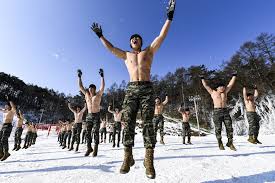Before the proliferation of modern gym facilities in the western hemisphere, American soldiers relied on a variety of traditional and innovative methods to maintain their fitness. The nature of military training and the lack of sophisticated equipment meant that soldiers had to be resourceful, using their environments and basic tools to perform exercises that kept them in combat-ready condition. Every unit is only as strong as their weakest member, after all.
Historical Context
Physical conditioning in the military has always been crucial, not only for performance in battle but also for the daily demands of military life. From the Revolutionary War through World War II, and into the early Cold War era, the concept of a "gym" as known today was virtually non-existent within the military. Fitness regimes were, as they still remain in part, primarily composed of calisthenics, marching drills, and manual labor.
Calisthenics and Basic Training
Exercises that don’t rely on anything but a person’s own body weight have long been the cornerstone of military fitness programs. Push-ups, sit-ups, jumping jacks, especially when done in a sand pit or in the middle of the night can be more effective than you’d think, it turns out. These exercises were favored for their simplicity and the fact that they could be performed anywhere, from barracks to the battlefield. Calisthenics provide a full-body workout that increases muscle strength, endurance, and flexibility, which are essential.
Utilizing the Environment
Like those sand pits mentioned earlier, troops often used their surroundings to enhance their physical training. Logs could be lifted for strength training, and rocks could be carried over distances to build endurance. Running or marching while carrying heavy equipment over varied terrain was a common practice that simulated battlefield conditions. This type of training not only improved physical toughness but also prepared soldiers mentally for the rigors of combat. Unless you were stationed somewhere flat with good weather and no sand fleas, in which case you can step on a Lego.
Drills and Combat Training
Military drills were another form of physical exercise that provided both physical training and discipline. These drills included long marches, often with full gear, which were standard practice. Soldiers would practice maneuvers that required quick changes in direction, rapid sprints, and staying low to the ground, mimicking the movements needed in combat scenarios. Hand-to-hand combat training and obstacle courses also played significant roles in physical conditioning, enhancing agility, speed, and strategic thinking. Of all types of fitness, this is the longest running method in history, and the army that maintained that discipline was often the victor regardless of the nation or time it came from.
Adaptations Over Time
As time progressed, particularly during and after World War II, the U.S. military began to formalize and improve physical training programs, integrating more structured exercises and even beginning to incorporate elements of sports and organized physical activities. Gym facilities began to crop up on bases, and modern fitness programs have, albeit very slowly, made their way into the different branches. The core activities of running, calisthenics, and manual labor remain prevalent out of utility, versatility, and lack of imagination (no, running five miles a day, every day, with no rest days, is definitely good for you, I heard that somewhere).
Before the modern gym was a staple in military life, American soldiers maintained their fitness through a combination of practical exercises, utilizing their environment, and fulfilling their daily military duties. This approach kept them physically prepared for the demands of military service but also ingrained a level of resourcefulness and adaptability that characterized the way American service members are seen to this day. As gyms and organized sports became more common in the military, these traditional methods still formed the foundation of military fitness training, but the more we learn, the stronger we become.



%201.svg)










